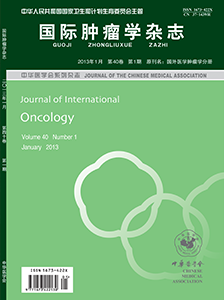Clinical epidemiological analysis of 2 403 cases of lung cancer
引用次数: 2
Abstract
Objective To understand preliminaryly the epidemiological trend of lung cancer in recent years by retrospective analysis of 2 403 cases of lung cancer in Zhongnan Hospital of Wuhan University from 2013 to 2017. Methods The clinical data of patients with primary bronchogenic cancer diagnosed in Zhongnan Hospital of Wuhan University from 2013 to 2017 were collected. The clinical data such as gender, age, history of tobacco and alcohol, operation, pathological type, clinical stage and epidermal growth factor receptor (EGFR) gene mutation were analyzed statistically. Results A total of 2 403 cases of lung cancer were collected, including 1 766 males and 637 females. There was no significant difference in gender ratio between male and female in five years (χ2=8.481, P=0.075). There were 2 398 cases with age information, the male-to-female ratios of lung cancer patients aged less than 40, 40-49, 50-59, 60-69, 70-79, 80 and over were 0.9∶1.0, 1.4∶1.0, 2.4∶1.0, 3.6∶1.0, 3.4∶1.0 and 3.3∶1.0 respectively, and the difference was statistically significant (χ2=59.004, P<0.001). The composition difference of adenocarcinoma was not statistically significant in five years (χ2=2.165, P=0.705). There was no statistically significant difference in the composition ratio of squamous cell carcinoma (χ2=4.788, P=0.310). Adenocarcinoma accounted for 43.15% (762/1 766) and 81.95% (522/637) of the pathological types of male and female patients respectively, and the difference was statistically significant (P<0.001). Squamous cell carcinoma accounted for 39.01% (689/1 766) and 7.28% (47/637) respectively, and the difference was statistically significant (P<0.001). The proportion of squamous cell carcinoma in smoking patients was 42.99% (583/1 356), which was significantly higher than that in non-smoking patients (14.61%, 153/1 047); the proportion of squamous cell carcinoma in drinking patients was 40.56% (277/683), which was higher than that in non-drinking patients (26.69%, 459/1 720), and the differences were statistically significant (both P<0.001). A total of 1 252 patients underwent surgery, accounting for 52.10% (1 252/2 403) of the total cases. The surgical rate of small cell carcinoma was 21.72% (48/221), and that of non-small cell carcinoma was 55.18% (1 204/2 182). In five years, the surgical rates of lung cancer patients were 55.11% (221/401), 51.53% (252/489), 58.23% (244/419), 53.18% (276/519) and 45.04% (259/575) respectively, and there was significant difference in the proportion of surgical and non-surgical patients in each year (χ2=19.553, P=0.001). A total of 483 patients were tested for EGFR mutation, the EGFR mutation rate was 58.8% (251/427) in adenocarcinoma patients and 15.6% (5/32) in squamous cell carcinoma patients. Among lung cancer patients aged less than 40, 40-49, 50-59, 60-69, 70-79, 80 and over, the proportions of adenocarcinoma were 76.74% (33/43), 62.39% (136/218), 57.73% (381/660), 47.95% (455/949), 52.22% (235/450) and 52.56% (41/78) respectively, and the difference was statistically significant (χ2=33.078, P<0.001); the proportions of squamous cell carcinoma were 9.30% (4/43), 21.56% (47/218), 28.03% (185/660), 34.14% (324/949), 32.44% (146/450) and 35.90% (28/78) respectively, and the difference was statistically significant (χ2=26.977, P<0.001). The difference of composition ratio of TNM staging was statistically significant in five years (χ2=21.003, P=0.034). Conclusion There has been no significant change of male-to-female ratio in patients with lung cancer in the past five years. With the increase of age, the male-to-female ratio increases first and then decreases. The proportion of adenocarcinoma and squamous cell carcinoma has not increased or decreased significantly in the past five years. Adenocarcinoma and squamous cell carcinoma are both common in male lung cancer patients, while the pathological type of female patients is mainly adenocarcinoma. Squamous cell carcinoma is highly prevalent in smokers and drinkers. The surgical rate of squamous cell carcinoma is higher than that of adenocarcinoma, and the surgical rate of non-small cell lung cancer is higher than that of small cell lung cancer. The EGFR mutation rate is higher in adenocarcinoma. With the increase of age, the proportion of adenocarcinoma in all pathological types tends to decrease, while that of squamous cell carcinoma tends to increase. The patients′ TNM staging has a downward trend, and the operation rate decreases slightly. Key words: Lung neoplasms; Epidemiology; Pathology2 403例肺癌临床流行病学分析
目的通过对2013 - 2017年武汉大学中南医院2 403例肺癌患者的回顾性分析,初步了解近年来肺癌的流行趋势。方法收集2013 - 2017年武汉大学中南医院诊断的原发性支气管源性癌患者的临床资料。对性别、年龄、烟酒史、手术情况、病理类型、临床分期、表皮生长因子受体(EGFR)基因突变等临床资料进行统计学分析。结果共收集肺癌病例2 403例,其中男性1 766例,女性637例。5年内男女性别比差异无统计学意义(χ2=8.481, P=0.075)。有年龄信息的2 398例,40岁以下、40-49岁、50-59岁、60-69岁、70-79岁、80岁及以上肺癌患者的男女比例分别为0.9∶1.0、1.4∶1.0、2.4∶1.0、3.6∶1.0、3.4∶1.0、3.3∶1.0,差异有统计学意义(χ2=59.004, P<0.001)。5年内腺癌组成差异无统计学意义(χ2=2.165, P=0.705)。鳞状细胞癌的构成比比较,差异无统计学意义(χ2=4.788, P=0.310)。男性和女性患者的病理类型中腺癌分别占43.15%(762/1 766)和81.95%(522/637),差异有统计学意义(P<0.001)。鳞状细胞癌占39.01%(689/1 766)、7.28%(47/637),差异有统计学意义(P<0.001)。吸烟患者患鳞状细胞癌的比例为42.99%(583/1 356),显著高于非吸烟患者(14.61%,153/1 047);饮酒患者的鳞状细胞癌比例为40.56%(277/683),高于非饮酒患者的26.69%(459/1 720),差异有统计学意义(P均<0.001)。手术1 252例,占总病例的52.10%(1 252/2 403)。小细胞癌手术率为21.72%(48/221),非小细胞癌手术率为55.18%(1 204/2 182)。5年肺癌患者手术率分别为55.11%(221/401)、51.53%(252/489)、58.23%(244/419)、53.18%(276/519)、45.04%(259/575),各年手术与非手术患者比例差异有统计学意义(χ2=19.553, P=0.001)。共检测483例患者的EGFR突变,腺癌患者的EGFR突变率为58.8%(251/427),鳞状细胞癌患者的EGFR突变率为15.6%(5/32)。在40岁以下、40-49岁、50-59岁、60-69岁、70-79岁、80岁及以上肺癌患者中,腺癌的比例分别为76.74%(33/43)、62.39%(136/218)、57.73%(381/660)、47.95%(455/949)、52.22%(235/450)、52.56%(41/78),差异有统计学意义(χ2=33.078, P<0.001);鳞状细胞癌的比例分别为9.30%(4/43)、21.56%(47/218)、28.03%(185/660)、34.14%(324/949)、32.44%(146/450)、35.90%(28/78),差异有统计学意义(χ2=26.977, P<0.001)。5年内TNM分期构成比差异有统计学意义(χ2=21.003, P=0.034)。结论近5年来肺癌患者的男女比例无明显变化。随着年龄的增长,男女比例呈现先上升后下降的趋势。腺癌和鳞状细胞癌的比例在过去五年中没有明显增加或减少。男性肺癌患者均以腺癌和鳞状细胞癌为多见,而女性患者病理类型以腺癌为主。鳞状细胞癌在吸烟者和饮酒者中非常普遍。鳞状细胞癌的手术率高于腺癌,非小细胞肺癌的手术率高于小细胞肺癌。腺癌中EGFR突变率更高。随着年龄的增长,腺癌在各病理类型中的比例呈下降趋势,而鳞状细胞癌的比例呈上升趋势。患者TNM分期呈下降趋势,手术率略有下降。关键词:肺肿瘤;流行病学;病理
本文章由计算机程序翻译,如有差异,请以英文原文为准。
求助全文
约1分钟内获得全文
求助全文

 求助内容:
求助内容: 应助结果提醒方式:
应助结果提醒方式:


